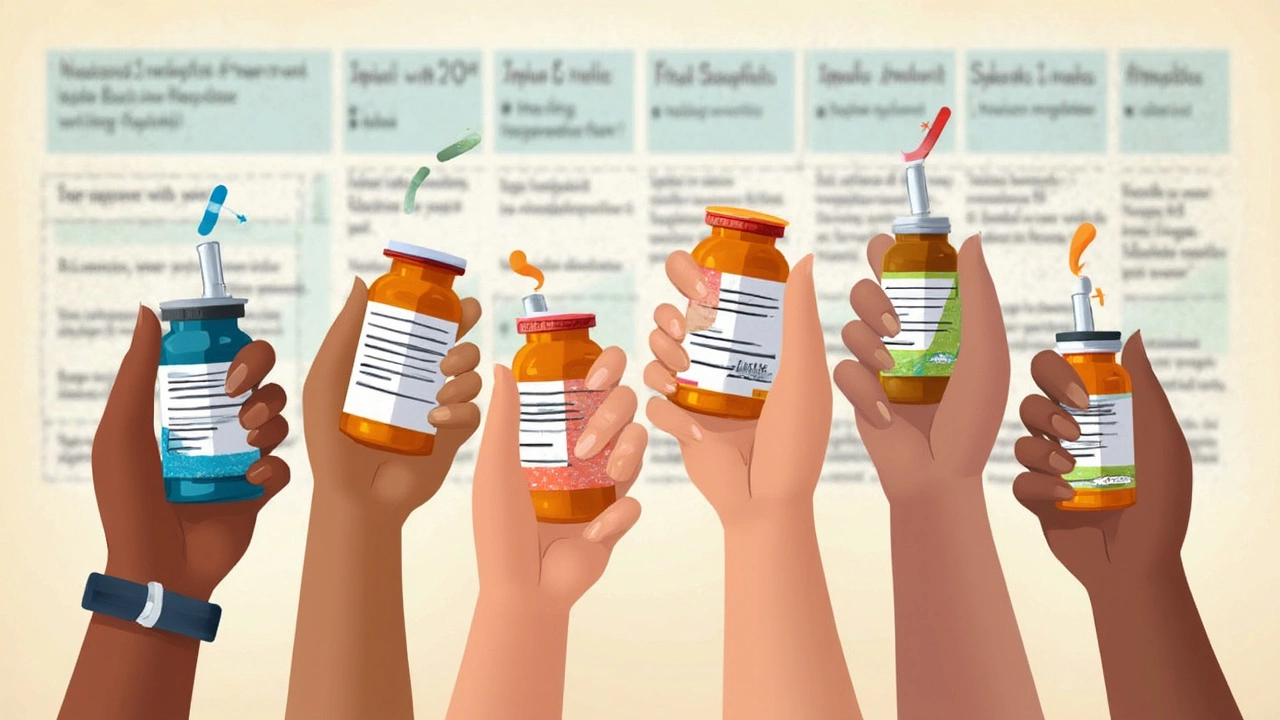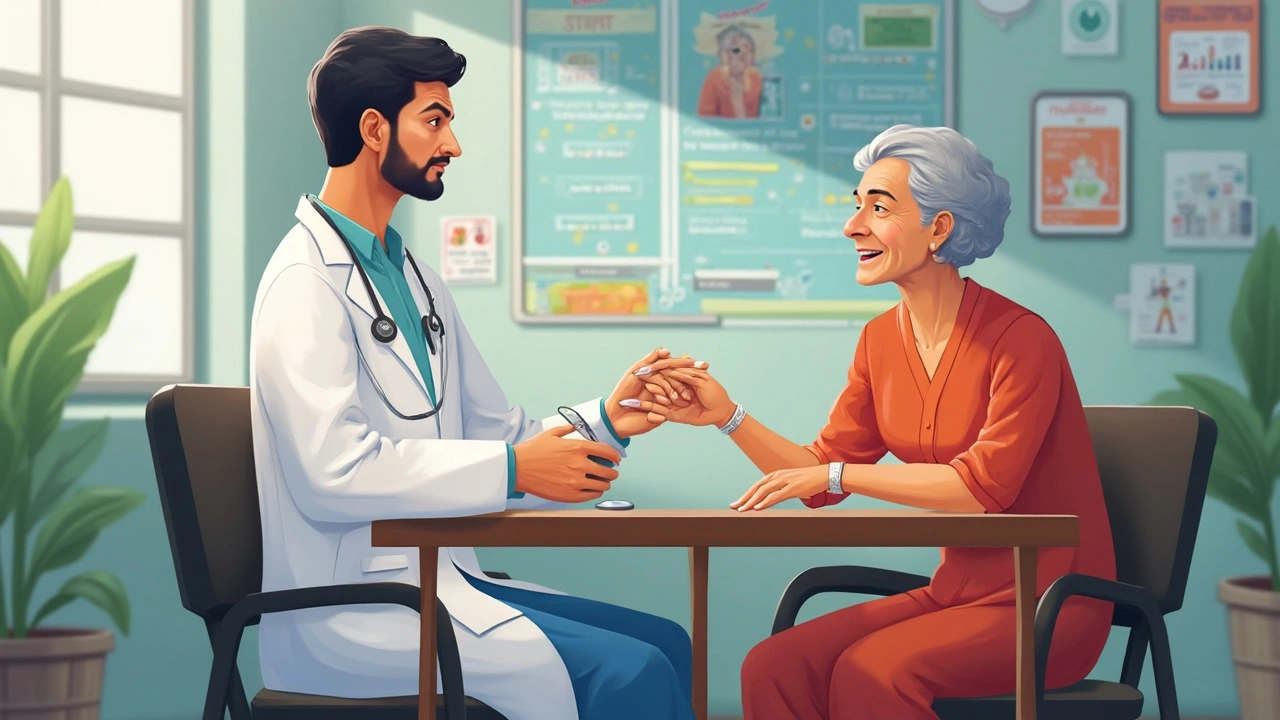-
27

Best Medicine for Diabetes: What Actually Works?
Picking the best diabetes medicine isn’t a simple one-size-fits-all answer. Instead, it’s a bit like choosing a new phone: what works perfectly for your friend might leave you frustrated. There are dozens of medications out there—some you swallow, some you inject, and a few that mix old-school reliability with cutting-edge science.
Ever wondered why your doctor is careful about switching your medicine or adding a new one? It’s because every drug brings its own mix of benefits and side effects. Some pills are famous for being easy on the wallet but might not help with weight or heart issues. Others, like newer injectables, come with perks like weight loss on top of blood sugar control, but they can cost more or need a steady hand with a needle.
If you’re staring at a handful of different tablets or feeling overwhelmed by talk of injections, you’re not alone. More than 540 million adults worldwide live with diabetes, and what helps control blood sugar for one person might not do the trick for another. Getting the right medication is about more than just numbers on a test—it’s about feeling better in daily life and avoiding complications down the road.
- Why Choosing the Right Diabetes Medicine Matters
- Meet the Main Types: Pills, Injectables, and Insulin
- Popular Diabetes Drugs: The Pros and Cons
- Tips for Sticking With Your Medication Plan
- What’s New and What’s Coming in Diabetes Medication
Why Choosing the Right Diabetes Medicine Matters
Picking the right diabetes medicine isn’t just about keeping blood sugar in the “normal” range. It’s about more than the numbers—it's about feeling less tired, protecting your heart, and avoiding scary long-term problems like nerve damage or kidney trouble. Some meds even help you shed extra pounds; others can actually help guard your heart against strokes or heart attacks.
If you’re thinking, “Isn’t any diabetes drug better than none?”—hold on. The risk of low blood sugar, side effects, cost, and how a drug fits your daily life can be huge. Metformin, for example, is one of the most prescribed drugs for type 2 diabetes. It’s cheap and usually easy to tolerate, but it isn’t perfect and doesn’t work well for everyone. Then you’ve got the GLP-1 drugs (like semaglutide), which are getting a lot of attention because they lower blood sugar and help with weight loss, but they can be pricey and sometimes cause tummy issues.
Here are a few things that make the choice so personal:
- Your age and how long you’ve had diabetes
- Other health problems—like high blood pressure or cholesterol
- History of heart or kidney issues
- How you feel about injections vs. pills
- Your insurance coverage or out-of-pocket costs
Check out this table showing how some common diabetes meds stack up on a few important points:
| Medicine | Type | Main Benefit | Possible Side Effects | Affects Weight |
|---|---|---|---|---|
| Metformin | Pill | First choice for many adults | Stomach upset | Neutral/loss |
| GLP-1 RA (e.g., semaglutide) | Injectable | Weight loss, heart protection | Nausea | Loss |
| SGLT2 inhibitors | Pill | Heart/kidney benefit | UTIs, yeast infections | Loss |
| Insulin | Injectable | Lowers blood sugar fast | Low blood sugar risk | Gain |
So if you’re serious about getting the best results—and protecting your body long-term—choosing the right diabetes medication truly does matter. It’s not just about one good lab result; it’s about living better every single day.
Meet the Main Types: Pills, Injectables, and Insulin
Let’s get straight to the three main ways diabetes is tackled: with pills, injectables, and insulin. Each path comes with real pros and cons, and knowing the difference helps you ask smarter questions at the doctor’s office.
First up are diabetes medication pills—usually for type 2 diabetes. These range from the trusted metformin, which has been on the market since the 1950s, to newer options like SGLT2 inhibitors and DPP-4 inhibitors. Metformin is almost always the starting point. It’s cheap, well-studied, and helps most people drop their blood sugar without too many side effects. Some people might get stomach issues, especially at first, but that usually settles down.
Next, there are injectables that aren’t insulin. One big family here is the GLP-1 receptor agonists—you might’ve seen names like Ozempic or Trulicity all over the news and social media. What’s cool here? These meds help lower blood sugar and often come with the bonus of weight loss. Some are daily, but newer ones are weekly, so you aren’t stuck poking yourself every morning. Just be ready for possible nausea, especially when starting out.
Insulin is the classic fix for type 1 diabetes, but many folks with type 2 eventually need it, too. There isn’t just “one insulin.” You’ve got long-acting types, short-acting types, and mixes. Some you take once a day, others before meals. People are often worried about the shots, but those tiny needles bother most people way less than they expect.
Here’s a quick look at some common examples, how they’re taken, and what they usually do.
| Name | Type | How It's Taken | Main Benefit |
|---|---|---|---|
| Metformin | Pill | Once or twice daily | Lowers sugar, cheap, weight neutral |
| SGLT2 inhibitors (e.g. empagliflozin) | Pill | Once daily | Protects heart/kidney, some weight loss |
| GLP-1 receptor agonists (e.g. Ozempic) | Injectable | Once weekly | Lowers sugar, weight loss |
| Basal Insulin (e.g. glargine) | Injectable | Once daily | All-day sugar control |
| Rapid Insulin (e.g. lispro) | Injectable | Before meals | Controls spikes after food |
Most people end up mixing these meds as their needs change. Type 2 often starts simple, then adds more as the body gets stubborn. Talk with your doctor about what fits your habits, budget, and comfort.

Popular Diabetes Drugs: The Pros and Cons
If you step into a pharmacy or scroll through diabetes forums, you’ll hear the same handful of meds pop up over and over. Here’s the real scoop on the ones that most doctors reach for—backed by what doctors see in real life and what the research shows.
Metformin has been the go-to for type 2 diabetes for decades. People like it because it’s cheap, lowers A1c by about 1-1.5 points, and rarely causes dangerous low blood sugar (hypoglycemia). On the flip side, it can upset your stomach, especially at first, and if your kidneys don’t work well, you may need to skip it or get close doctor monitoring.
SGLT2 Inhibitors—drugs with names like empagliflozin (Jardiance) or dapagliflozin (Farxiga)—are trending. They help your body pee out extra sugar and have solid proof they protect your heart and kidneys. Pros include weight loss and lower blood pressure. Downsides? Higher price, and a slightly higher risk of yeast infections or, rarely, a serious infection called Fournier’s gangrene.
GLP-1 Agonists—like semaglutide (Ozempic) or liraglutide (Victoza)—aren’t just blood sugar fighters; they curb appetite and often lead to steady weight loss. They also lower some people’s risk of heart attack. But they’re given as injections, aren’t cheap, and can cause nausea or vomiting, especially in the first months. Some folks have reported gallbladder issues down the road too. If you’ve seen Ozempic all over social media, this is why.
Sulfonylureas—like glipizide or glyburide—have been around longest. They bring down blood sugar fast and cost less than a burger combo meal. But they can cause diabetes medication-related side effects like weight gain and low blood sugar, so they’re not many doctors’ first pick anymore for new patients.
DPP-4 Inhibitors—think sitagliptin (Januvia)—are tablet drugs that don’t have much drama. They’re easy to use and come with fewer side effects, but they don’t usually drop blood sugar as much as others and don’t change weight.
Want a quick comparison? Check out this table:
| Drug Type | Main Pros | Main Cons | Typical A1c Drop |
|---|---|---|---|
| Metformin | Cheap, safe for heart, no weight gain | Stomach upset, not for bad kidneys | 1-1.5% |
| SGLT2 Inhibitors | Heart & kidney protection, weight loss | Urinary/genital infections, expensive | 0.5-1% |
| GLP-1 Agonists | Weight loss, helps heart, appetite control | Nausea, cost, shots | 1-1.5% |
| Sulfonylureas | Cheap, works fast | Weight gain, risk of low blood sugar | 1-2% |
| DPP-4 Inhibitors | No weight change, easy to use | Less powerful, costly | 0.5-0.8% |
This isn’t a complete list—there are combos, older meds, and of course, insulin. Most people start with one and add others as life (and blood sugar) demands.
Tips for Sticking With Your Medication Plan
Let’s be real—remembering to take your diabetes medication every single day can feel like a constant buzz in your head. Only about 50% of people with chronic illnesses take their meds exactly as prescribed. That’s a whole lot of missed doses, and it seriously affects blood sugar control.
Missing even just a few doses a week can raise your A1C, mess up your daily schedule, and even lead to hospital visits. But there are ways to make sticking to your medicine routine much easier:
- Set alarms on your phone. The classic reminder never goes out of style. Set one for each dose, or use a daily habit app.
- Link meds to a daily habit. Keep your pills next to your toothbrush or coffee mug, so you see them at the right time each day.
- Use a pill organizer. Those simple weekly containers make it obvious if you’ve missed a pill. You can grab one at any pharmacy.
- Make a chart or checklist. Hang it on the fridge and check off each dose after you take it. Still works, even in 2025.
- Ask about fewer doses. Newer drugs are designed for once-a-week or once-daily dosing. It’s worth asking your doctor—fewer doses mean fewer chances to forget.
- Talk to your doctor about side effects. If your meds make you feel lousy, you won’t want to take them. Don’t suffer in silence; there are always options.
Having someone in your corner helps. Some people team up with a family member or friend who checks in. Your pharmacist can also text you refill reminders or even help set up automatic refills.
Here’s a quick look at what happens when you skip meds, based on data from research studies:
| What Happens When You Miss Your Diabetes Medicine? | Percent Increase in Risk |
|---|---|
| Higher risk of hospital admission (within 1 year) | 40% |
| Increased A1C after 3 months of missed doses | Average 0.6% higher |
| More chance of diabetes complications (nerve, kidney, eye issues) | About 30% higher |
Nobody gets it right 100% of the time. If you miss a dose, don’t panic—just get right back on track. Being open with your doctor about your real-life routine gets you a plan that works for you, not just for the textbook.

What’s New and What’s Coming in Diabetes Medication
This past year, diabetes treatment has seen some game-changers. If you think diabetes care is all about old-school pills and regular insulin shots, think again. There’s a fresh wave of meds and tech making life with diabetes a lot easier—and maybe even a bit lighter on stress.
The hottest topic at diabetes clinics right now? GLP-1 receptor agonists. These are a group of injectable meds like semaglutide (brand name Ozempic) and tirzepatide (brand name Mounjaro) that not only drop your blood sugar but also help with weight loss. Studies from 2024 showed average blood sugar (HbA1c) reductions of up to 2%—that’s a big deal, especially for people struggling to hit their targets. Plus, a lot of folks are dropping 10% or more of their starting body weight with these drugs.
Another huge leap is the rise of combo medicines. Some new pills and shots now pack two or even three effects into one dose: control blood sugar, curb appetite, and protect your heart. It means less juggling bottles and more getting on with your day.
- Semaglutide (Ozempic & Wegovy): Lowered A1c and significant weight loss.
- Tirzepatide (Mounjaro): Dual action for blood sugar and fat loss.
- SGLT2 inhibitors (like Jardiance): Protect kidneys and the heart, not just blood sugar.
Smart tech is also making waves. Bluetooth glucose monitors send your sugar readings right to your phone, and some new insulin pens count your doses for you—no more guessing if you took your shot. Closed-loop “artificial pancreas” systems are available in more countries, which can automate insulin based on your sugar levels almost 24/7.
The pipeline’s stacked with even more options. Pills that act like GLP-1s are in late stage trials, so in a couple of years you might not need needles at all for some of the hottest diabetes drugs. Researchers are working on weekly and even monthly shots, hoping to make the treatment routine even simpler.
| Medication | How It Works | Main Benefits |
|---|---|---|
| Semaglutide (Ozempic/Wegovy) | GLP-1 agonist | Lowers A1c, weight loss, heart protection |
| Tirzepatide (Mounjaro) | GLP-1/GIP agonist | Strong blood sugar & weight loss effects |
| SGLT2 inhibitors (Jardiance/Farxiga) | Kidney/sugar excretion | Protect kidneys, good for heart |
If you haven’t talked to your doctor about these newer options, now’s a good time. The field is finally catching up to what people with diabetes have wanted: treatments that fit life, not life that fits medicine. The best medicine for diabetes isn’t just about numbers—it’s about actually living better. Just remember, the best medicine for diabetes today might get even better tomorrow, and that’s a game worth paying attention to.